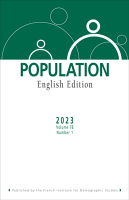
Population 2023 n°1
2023
Editorial
Damien Bricard, Géraldine Duthé, and Delphine Remillon
Trajectories and Origins 2 (2019–2020): A Survey on Population Diversity in France
Cris Beauchemin, Mathieu Ichou, Patrick Simon, the TeO2 survey design team
We’re Just Careful’: How Surveys Have Measured Use of the Withdrawal Method in France Since the 1970s
Cécile Thomé
Living Apart Together: 40 Years of Sociodemographic Research on LAT Relationships
Christophe Giraud
Children Who Have Never Gone to School: How Regional Heterogeneity Shapes Access to Primary Education in Uganda
Christian Kakuba and Valérie Golaz
Trajectories and Origins 2 (2019–2020): A Survey on Population Diversity in France
Cris Beauchemin, Mathieu Ichou, Patrick Simon, the TeO2 survey design team
This article presents the second edition of the Trajectories and Origins survey (TeO2), a reference survey on population diversity in France organized jointly by the French Institute for Demographic Studies (INED) and the National Institute of Statistics and Economic Studies (INSEE). A follow-up to TeO1, TeO2 addresses the continued demand for large-scale data to measure the integration of immigrants and their descendants, and the discrimination to which they are exposed. After a complex sampling procedure, questionnaires were completed by 27,181 individuals aged 18–59 representative of the population living in metropolitan France. Immigrants, people from the French overseas departments and regions, and the second generations of these two groups were over-represented. The multi-thematic questionnaire, administered face-to-face in most cases, covers numerous spheres of the respondents’ social lives. The grandchildren of immigrants can be identified for the first time.
We’re Just Careful’: How Surveys Have Measured Use of the Withdrawal Method in France Since the 1970s
Cécile Thomé
Based on the study of the withdrawal method for contraception, this article analyses the methodological challenges that face researchers investigating ‘invisible’, stigmatized, and difficult-to-measure practices. The article starts by reviewing research aimed at determining the prevalence of withdrawal use in France before the 1960s and examines the reasons behind the progressive stigmatization of this practice by the Church and the medical establishment due to its status as a sexual practice. By comparing nine quantitative surveys conducted in France since the 1970s and drawing on the international literature on the topic, this article suggests methodological considerations for best capturing this form of contraception, one that, often, respondents do not even consider a method of contraception or do not report using. It looks at the most effective ways of asking questions about this practice (framing, vocabulary used, double-check questions, etc.) and highlights the importance of considering temporality to ensure that withdrawal is better situated within the ‘mosaic’ of more effective methods that may conceal its use in favour of a single ‘principal method’.
Living Apart Together: 40 Years of Sociodemographic Research on LAT Relationships
Christophe Giraud
This article retraces the history of research on non-cohabiting unions, today commonly called living apart together (LAT) in the international scientific literature, and how they were first brought to light. The notion was first used in 1980 by the Dutch demographer Cees J. Straver, then redefined by Jan Trost and John Haskey in the early 2000s. It was gradually included and operationalized in national and international statistical surveys conducted in the 1990s and 2000s. LAT relationships have been analysed from various angles: comparison of non-cohabiting relationships with other partnerships (marriage and consensual union), comparison of different types of noncohabiting relationships, and analysis of their outcomes over time. This intellectual history is punctuated by a recurring question: are these relationships the consequence of structural constraints (e.g. long periods in education, difficulty finding a stable job, etc.) or do they reflect the emergence of new values and expectations?
Reluctant Fathers? A Mixed-Methods Approach to Grasp the Diversity of Mechanisms Behind Paternity Leave Non-Take-Up
Alix Sponton
From its introduction in 2002 to its reform in 2021, 11-day paternity leave was an immediate success in France. Short, generous, and consistent with the contemporary norms of ‘good’ parenting, it combined all the necessary ingredients to ensure high take- up rates. In this favourable context, it is not so much the fathers who take their leave, but rather those who forgo it that raises questions. Who are these fathers? Why do they forfeit this right? Are they advocates of a ‘traditional’ paternal role, with a strong attachment to the male breadwinner model? This article uses mixed methods to identify the characteristics of fathers who do not take their paternity leave and explores the mechanisms underlying this non-take-up. While giving priority to work over paternity leave offers one angle of analysis, this excludes a large share of non-takers, such as new fathers without stable salaried employment. This article explores the multiple factors in non-take-up that may also include inadequate information or administrative obstacles.
Children Who Have Never Gone to School: How Regional Heterogeneity Shapes Access to Primary Education in Uganda
Christian Kakuba and Valérie Golaz
Although Uganda was among the first sub-Saharan countries to introduce universal primary education in 1997, about 6% of children aged 9–11 had never been to school in 2014. An analysis of a 10% sample of the latest Uganda Population and Housing Census (2014) data set highlights striking spatial inequalities. We compare results from separate logistic regression analyses for the Karamoja subregion, the rest of the country, and the country as a whole. Our multilevel analyses show that the role played by household heads’ education and wealth in school enrolment emerges as a common factor. But while girls were significantly more likely to have never been enrolled in Karamoja and boys in the rest of Uganda, sex was not significant in the national model. Gendered expectations and constraints differ, which policies must consider. Our analysis questions the relevance of national models and therefore many national-level results in a context of high subnational heterogeneity.

